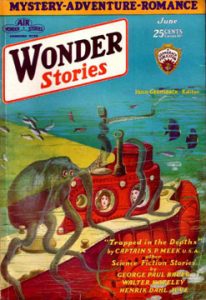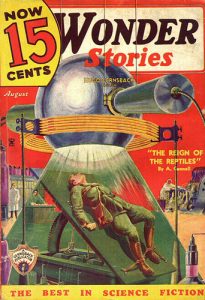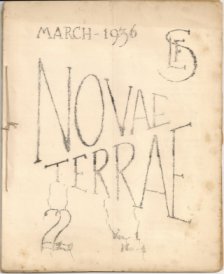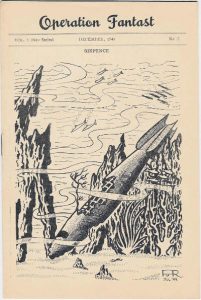Over the next few weeks, we will be bringing you one of the definitive histories of Irish and UK fandom. Rob Hansen has very kindly allowed us to reprint extracts from his ongoing and always in progress account of how fandom developed on these two shores, an absolutely fascinating history of how and why fandom is so important to us in Ireland. We very much hope you enjoy reading about this, and we’d like to thank Rob for his huge generosity in allowing us to publish this. If you’d like to read more, the original Then can be found here, and the ebook is available here.
Prologue:
In 1930 Hugo Gernsback‘s AMAZING STORIES magazine sponsored the Science Correspondence Club (or SCC), an idea of Ray Palmer’s that came into existence with the aid of Gernsback and which later metamorphosed into the International Scientific Association (or ISA). But though AMAZING was the first to see the potential in starting a fan club for its readers it was another SF magazine that was to be the most influential in the formation of fandom on the other side of the Atlantic.
Wonder Stories, June 1930
The letters page in WONDER STORIES, ‘The Reader Speaks’, indirectly sparked the formation of the first British fan group when a letter in the June 1930 issue from Len A.Kippin of Ilford led to 18 year-old Walter Gillings’ first meeting with another fan. He wrote to Kippin, who responded promptly to Gillings’ overtures, and the Ilford Science Literary Circle was born. Gillings wrote of the Ilford Circle’s activities in letters to the American prozines and his accounts in WONDER STORIES brought him to the attention of fans in other UK cities, resulting in the creation of Britain’s second SF club, the Universal Science Circle, which was formed in Liverpool by Les Johnson in 1931. Britain’s third SF fan group was appeared in Hayes, Middlesex, in 1932. Unlike the previous two groups WONDER STORIES does not appear to have played a part in its creation, but it would be directly responsible for the next five.
Wonder Stories, August 1935
Patterned after the SCC/ISA, the Science Fiction League was started by Gernsback and Charles D.Hornig at WONDER STORIES in May 1934. A few months after its formation came the first proposal for a British chapter of the SFL from Les Johnson but his appeal fell on deaf ears (and, in fact, there appears never to have been a Liverpool chapter). However, during 1934-35 so many letters from UK fans were printed in AMAZING and WONDER STORIES that the latter made its August 1935 ‘The Reader Speaks’ department a ‘British Edition’. By this time Gernsback had gotten the message, and of the thirty-seven chapters of his Science Fiction League that were granted charters up to the time that Startling Publications became its new sponsors, Mort Weisinger its new secretary, and the magazine was re-named THRILLING WONDER, five were in the UK. The first of these, Chapter no. 17 was in Leeds. It would eventually grow to be the country’s most active fan group. Hot on the heels of Leeds SFL came a Belfast chapter, Chapter no.20, with Hugh C.Carswell as Director, becoming simultaneously the fifth fan groupin the UK and the first in Ireland. Within eighteen months other SFL chapters would spring up in Glasgow (Chapter no.34), and Barnsley (Chapter no.37).
Novae Terrae March 1936
The first true UK fanzine was NOVAE TERRAE, published by Maurice K. Hanson and Dennis A.Jacques for the Nuneaton chapter of the SFL. The premiere issue appeared in March 1936 and there were another twenty eight, the last in January 1939. On Sunday 3rd January 1937 some twenty SF fans assembled in the Theosophical Hall, Leeds, for the first ever science fiction convention to be held anywhere (rival claims are sometimes made that a gathering in the US a few months prior to this constituted the first SF
convention but these are disregarded by serious fanhistorians). Most of those who attended lived locally, but six prominent fans came from other parts of the country. London was represented by Ted Carnell, Arthur C.Clarke, and Walter Gillings; Liverpool by Les Johnson and Eric Frank Russell; and Nuneaton by Maurice K.Hanson.
UK fandom was anxious to establish a good image for itself and after lunch on that Sunday afternoon the convention met to consider a proposal made by Leeds SFL for a non-commercial organisation to further the cause of science fiction in Britain. This was the Science Fiction Association and it was set up “…to encourage publishers to pay more attention to scientifiction and
to stimulate public interest in science”. The intention was to ask the UK SFL chapters to become branches of the new organisation and to encourage the formation of other branches throughout the country.
In May 1937 an attempt was made to contact Barnsley SFL to ask it become part of the SFA but the group had dissolved. At its height, a few months earlier, it had acquired six members and been rare among British groups in being composed mainly of science enthusiasts who thought that science fiction should be subordinated to the active furtherance of science. It had soon collapsed, a fate suffered by Belfast SFL around the same time when its Director, Hugh C. Carswell, joined the RAF. Glasgow SFL circulated a ‘Petition for Science’ in early-1937 and then it, too, vanished.
In order to form an SFL Chapter you needed three people, which means that there were at least two people other than Carswell in Belfast SFL, but who they might have been is unknown. In 1952, James White went in search of Carswell and Walt Willis wrote a somewhat fictionalised account of his quest that can be read here:
(And you’ll be seeing more of James and Walt in subsequent installments of this series.)
When Britain declared war on Germany in September 1939 following the German invasion of Poland, it was immediately decided to suspend the Science Fiction Association for the duration. It was never unsuspended. However, the need for a national organisation was still felt, and in June 1942 the British Fantasy Society came into being. (NOTE: This is no relation to the current organisation of the same name, which was started in 1971 and originally called the British Weird Fantasy Society.)
The final issue of its official organ, the BFS BULLETIN was dated November 1946, the society’s last gasp. With the dissolution of the BFS, Ron Holmes and Nigel Lindsay, who at this point made up about half of the remaining active membership, combined its library and chain letter to form a new organisation called the British Fantasy Library. The BFL published its own official organ, BOOKLIST (which contained more news and notes than actual booklists). This was not the national organisation fans in the provinces were looking for, however.
Operation Fantast, December 1949.
Many who lived through this period credit Ken Slater with UK fandom’s eventual revival nationally. In September 1947 he published OPERATION FANTAST, which went out bound with the BFL’s BOOKLIST when Slater took advantage of an offer from Holmes and Lindsay to circulate free of charge any fanzines sent to them. The second issue of OF, dated December but mailed in January 1948, was a separate publication, the first generally available fanzine to see print in the country in almost a year, and it sparked off the first post-war boom in fanzine publishing. OF remained associated with the BFL and Slater found himself running a department in the organisation that he describes as:
“…a sort of ‘bring-and-buy’ agency for the BFL’s surplus magazines and books – and, of course, my own material. Officially, the original OPERATION FANTAST was the liaison department of the BFL and it remained that way through most of 1948.”
So, things were coming together but recovery was still slow, however, and fanzines were still rare enough for each new title to cause excitement. Thus far, fandom in Ireland – such as it was – had made little impact and barely been noticed by fans in Britain and North America.
All that was about to change.





